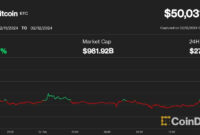Ethereum Merge Date Is Set For June 8. Here’s Why Experts Are Excited – cryptokinews.com
A successful merge of the Ropsten testnet and its beacon chain would be a good indication of what would happen with the mainnet transition.
Ethereum’s Ropsten testnet successfully launched its proof-of-stake (PoS) beacon chain on May 30 as the highly anticipated merge of the network draws nearer.
Ethereum developer Tim Beiko announced the development on Twitter, describing it as the first dress rehearsal of the main event. According to available information, the beacon chain will merge with Ropsten testnet on June 8.
Decentralized, open-source blockchain computing platform, Ethereum, introduced on Monday its launch of the Eth2 Beacon Chain set to quickly merge with public testnet, Ropsten. Specialists have been anticipating an occasion generally known as “the merge” for fairly a while, and Monday’s launch carries reignited hope that the merge will certainly occur.
A Ropsten testnet merge was introduced to occur June 8, getting ready for the ultimate merge, set for someday later this yr. The merge will fuse the Eth2 Beacon Chain with the Ethereum mainnet, in the end transiting the community from proof-of-work (PoW), to proof-of-stake (PoS). Ethereum developer, Tim Beiko, made the official announcement on Twitter saying, “Ethereum’s longest lived PoW testnet is transferring to Proof of Stake! A brand new beacon chain has been launched in the present day, and The Merge is anticipated round June eighth on the community,” the developer mentioned, calling it “the primary gown rehearsal.”
The transfer from proof-of-work to proof-of-state
Presently, Ethereum operates by means of a proof-of-work, or PoW, community. A proof-of-work community, aiming to forestall assaults, asks miners to resolve puzzles to finish a block of transactions, verifying the transactions are respectable. PoW, initially constructed into the design of Bitcoin, has been replicated by different cryptocurrencies, together with Ethereum.
Ethereum builders have been engaged on upgrading Ethereum 2.0, which can transition the community to proof-of-stake. Additionally aiming to safe transactions, proof-of-stake will omit using {hardware} assets and as a substitute have validators dedicate their cryptocurrency by locking up at the very least 32 ETH that they can not spend. Eliminating using superior {hardware} will enable extra customers to take part, furthering decentralization and resistance to assaults. The improve is predicted to scale back Ethereum’s vitality consumption by greater than 99% and its issuance by 90%.
One other supply of pleasure for the merge comes with a prediction of the cryptocurreny’s deflationary worth. Analysts imagine the merge may burn extra ETH than is created by means of validator rewards due to its transactionary base charge being burnt, making it deflationary.
Testnet merge dependencies
Beiko shared two circumstances that must occur for the beacon chain to merge with Ropsten testnet in simply over every week. First, the beacon chain must activate the Bellatrix improve. Then, a PoW complete issue worth, the Terminal Complete Issue (TTD) will likely be chosen to set off the transition. This determination by builders can be made between June 2 and June 3 with a purpose to create a seamless transition.
Why The Merge is a Big Deal
The Merge is Ethereum’s most highly anticipated upgrade since inception. It involves docking the current Ethereum proof-of-work blockchain with the new Ethereum Consensus Layer (formerly known as ETH 2.0) proof-of-stake chain, which will take over as the primary consensus mechanism, ending the energy-intensive mining process.
This will reduce network energy consumption by more than 99% since power-hungry mining rigs are no longer necessary to validate blocks. Consensus will be achieved by staking the asset (ETH) into a smart contract instead. With all the negativity surrounding the energy consumption of Bitcoin (BTC) and proof-of-work cryptocurrencies, this will be good news for Ethereum.
Contrary to many reports, the Merge will not significantly reduce network fees which are paid in gas. This will only occur when further scaling upgrades are implemented on the network. However, these upgrades are not expected until 2023, so for now, layer-one Ethereum will remain costly to use when under heavy loads, but there are plenty of layer-two options.
At the time of writing, there was 13.3 million ETH staked on the Beacon Chain, according to the Launchpad dashboard. This is equivalent to around 11% of the entire supply and is worth around $26.5 billion at current prices.
There have also been conflicting reports about all of this collateral being sold to markets when the Merge takes place, and it is freed up from the staking smart contract. However, the ETH will be released in tranches several months after the Merge, so there will be no mass liquidation event.
ETH Prices Up 6%
Ethereum prices have gained 6.2% on the day, briefly topping $2,000 during the Tuesday morning Asian trading session. ETH is currently trading at $1,991, which has wiped out the past weeks’ losses.
However, Ethereum has lost 27% over the past month and is trading down almost 60% from its November all-time high.
Crypto markets in general have gained 5.8% on the day as total market capitalization reaches $1.37 trillion. Nevertheless, the bears are still in complete control of the longer-term trend, and there is likely to be more pain before any significant turnaround.


